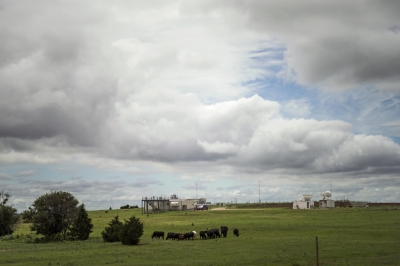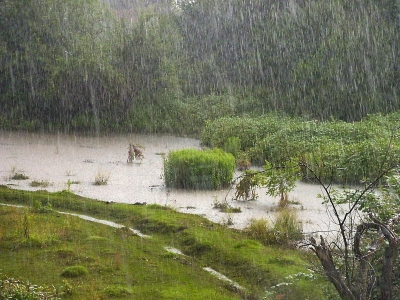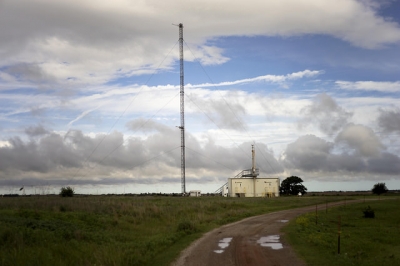ARM site plays a role in a novel finding on rain events and airborne carbonaceous particles

On March 26, 2014, a strong rainstorm swept through a region of open farmland around Lamont, Oklahoma. The next day, a scientist looking at an air sample collected during the rain event made an observation that could alter the way we look at rain’s effect on the climate.
The scientist was taking advantage of a sample collected just southeast of Lamont, on a 160-acre spread of cattle pasture and wheat fields. It’s the home base of the Southern Great Plains (SGP) Central Facility, the first and largest field instrument site established by the U.S. Department of Energy’s Atmospheric Radiation Measurement (ARM) Climate Research Facility—an Office of Science national user facility. (Its remote instrument clusters are sited throughout 55,000 square miles of north-central Oklahoma.)
Tiny Glass Spheres
Mary K. Gilles, a chemical scientist at the Lawrence Berkeley National Laboratory who has funding support from DOE’s Atmospheric System Research, was the one at the microscope that day, peering at an air sample full of tiny, glassy particles shaped liked spheres. They were so novel, and seemed so out of place, they prompted her to write in her lab notebook, “Something is wrong with these samples.”
Over the next year, the tiny glass spheres collected on the ARM aerosol observing system stack were chemically analyzed at several of DOE’s national laboratories. These miniature spheres, each only a half a micron wide and made largely of carbon, oxygen, and nitrogen, went on to inspire a paper published in Nature Geoscience on May 2. Gilles is a co-corresponding author.

Big Role in Climate
The study concludes that as much as 60 percent of particles that go airborne after a rainstorm come from the soil in the guise of the glassy spheres first observed at SGP. (At least in grassland areas, or in areas of tilled soil, they point out.) As rain falls, the idea goes, splashing creates air bubbles which mix with the dissolved matter of the soil. Floating upward, the bubbles burst, releasing a mist of organic compounds from the soil. Once in the air, the droplets dry and become the solid glassy organic particles Gilles saw under the microscope. They can drop to the ground, or travel thousands of miles in the air.
The paper’s authors also conclude that the abundance of these carbon-based organic particles, one-hundredth the size of a human hair, means they play a big role in how much sunlight hits the Earth. That means a big role in climate change. Intensive analysis by chemical imaging and micro-spectroscopy of the particles’ physical and chemical properties, the paper said, suggest they “may have important impacts on cloud formation and (may) efficiently absorb solar radiation.”
Finding a new source of the airborne particles, known as aerosols, is important for scientists seeking to understand the planet’s climate. To date, such solid and semi-solid organic aerosols have been poorly understood and “typically neglected” in climate models, the paper stated. “The idea of rain producing aerosols, much less solid ones, just hasn’t been on anyone’s radar,” said Gilles. “Rain cleans the atmosphere; it hadn’t occurred to me to think of rain as a mechanism to produce solid particles from soil.”
Unique Properties
Corresponding author with Gilles on the study is chemist Alexander Laskin, a senior research scientist at Pacific Northwest National Laboratory. “This is a new mechanism for bringing carbon from the soil into the air,” said Laskin, who led the study, which was funded by DOE’s Office of Science and PNNL. “These particles have a unique set of physical and chemical properties and they may have a substantial effect on the Earth’s climate.”
Laskin directed one of the study’s analysis teams at EMSL, the Environmental Molecular Sciences Laboratory, one of three DOE Office of Science user facilities central to the Nature Geoscience study. The others were the Advanced Light Source at Lawrence Berkeley National Laboratory and the ARM Facility. Data and analyses also came from Canadian Light Source and the National Oceanic and Atmospheric Administration. For the study, researchers used “routine operation data” from the SGP site, the paper stated. But they also acknowledged the assistance of SGP instrument technicians Kenneth Teske and Patrick Dowell.

Air Grab
Dowell has since left the ARM field site in Oklahoma, but Teske supplied the story about a guest instrument at the SGP that played a role in the discovery: a four-stage Sioutas Cascade Impactor, a small cylindrical device that captures airborne particles according to their dimensions. After a 25-minute air grab, the air samples are stored on sampling disks the size of a dime.
Gilles had asked him to mount the device on the stacks of an “aerosol trailer” on SGP’s Central Facility site near Lamont, said Teske. It was the first time the impactor had ever been used there. Mounting the soup can-size instrument on the stacks involved attaching a pump to the bottom end and attaching the other end to the aerosol inlet stack.
“It was supposed to be a one-off test,” he said. But the results were so startling in March 2014 that two more air tests were done with the impactor: one in September before a rainstorm and one in October after a rainstorm.
You can find the Nature Geoscience article online.
For more information, read the press release from Pacific Northwest National Laboratory.
To view a related video, go to YouTube.
# # #
The ARM Climate Research Facility is a national scientific user facility funded through the U.S. Department of Energy’s Office of Science. The ARM Facility is operated by nine Department of Energy national laboratories, including Argonne National Laboratory, which manages ARM’s Southern Great Plains megasite.

